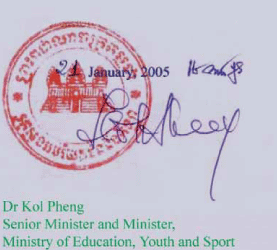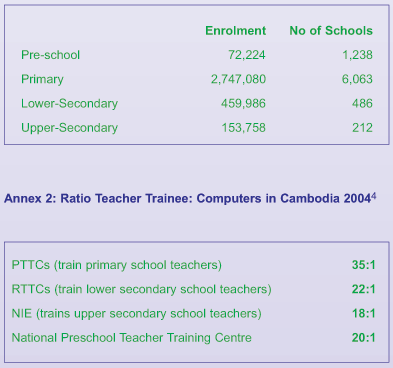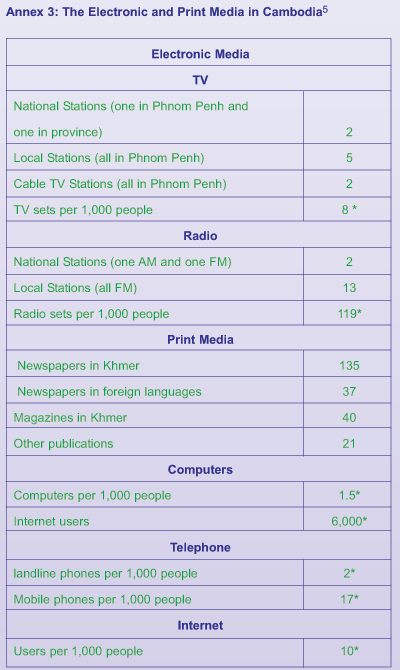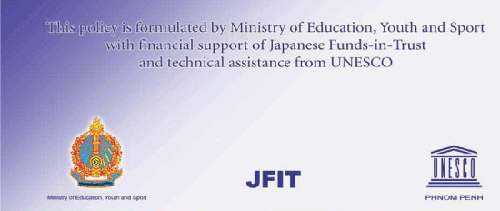Policies and Strategies on ICT in Education in Cambodia

PREFACE
Our current policy and strategies on information and communication technology (ICT) in the education system earmarks a sensitive challenge of the Cambodian Ministry of Education, Youth and Sport (MoEYS) to reform its delivery services effectively within a new context of universalization.
This educational ICT policy and strategies is a practical path we have chosen to get along well with the world trend of implementing the strategies and the national goals of education for all. Emphasis is also made on the non-formal education, distance education, training of professionals, education quality at upper-secondary education and post-secondary education levels through ICT, which is now becoming a relevant life skill required in a knowledge-based society and a critical tool for building partnership between government institutions, concerned national and international organizations, civil society and communities and legal entities within the private sector as well.
Moreover, this policy also clearly advocates its vivid encouragement and strong support to the use of ICT for the benefits of disadvantaged communities. Valuable insights for the development of such an educational policy giving favours to the establishment of a range of courses for ICT professionals are derived from a number of important documents such as the Strategic Plan for the Poverty Alleviation, the Second National Socio-Economic Development Plan, the Millennium Development Goals and the Education Strategic Plan (ESP) 2004- 2008.
In conclusion, the Ministry of Education, Youth and Sport would like to express its profound gratitude to UNESCO for providing technical and financial assistance to the formulation of this valuable educational ICT policy. My deep appreciation must also go to all of my colleagues and other friends from other concerned institutions, who worked hard in bringing about this policy for the benefits of our Cambodian citizens.
MoEYS is firmly convinced that this ICT in education policy will certainly contribute to creation of more pools of qualified human resources for Cambodia.

VISION
The long-term vision of Education for All in Cambodia is to ensure equal access to quality basic education for all citizens and to prepare its citizens to play an active role in reconstructing the country as well as integrating Cambodia to the knowledge-based global community. The Ministry of Education, Youth and Sport (MoEYS) is introducing various initiatives to facilitate greater integration of information and communication technology (ICT) to improve the effectiveness of education at all levels and to produce the technologically literate, productive and critically thinking workforce for the country.
GOALS Increased access to basic education for all, both formal and nonformal, using ICT as one of the major tools for learning, teaching, searching and sharinginformation.
Improved quality of basic education and promote independent and lifelong learning, especially for post-primary education,
Availability of workforce with the ICT skills needed for employment and use in a knowledge-based society; to ensure that Cambodia can compete and cooperate in an increasingly interconnected world.
POLICY OF ICT IN EDUCATION
The Ministry’s articulation of the policy for ICT in education focuses on four main areas: The first area is provide access to ICT for all teachers and students, especially at secondary level, ensuring that ICT is used as an enabler to reduce the digital gap between Cambodian schools and other schools in neighbouring countries.
The second area emphasizes the role and function of ICT in education as a teaching and learning tool in different subjects, and as a subject by itself. Access to information on the Internet and increased communication, via email, between schools and individuals can play an important role in the professional development of educators. In addition to radio and television as a teaching and learning tool, this policy stresses the use of the computer for accessing information, knowledge, skills, and communication.
The third area is to promote education for all regardless of age, gender, ethnicity, disability or location through distance education and self-learning, especially for deprived children, youth and adults who lack access to basic education, literacy and skill training, by integrating ICT with radio, television, printed materials and other media.
The fourth area emphasizes using ICT to increase productivity, efficiency and effectiveness of education management. Through the use of information management systems, ICT will be extensively used to automate and mechanise work such as the processing of student and teacher records, communication between government and schools, lesson planning, assessment and testing, financial management and the maintenance of inventories.
1. BACKGROUND
After almost 30 years of devastating war in Cambodia, the Royal Government of Cambodia is trying to develop its human resources in order to reconstruct the country and integrate it into the regional and global community.
The current stage of development of education is still at an early stage compared with its neighbours.
The government and international community are working together to achieve the EFA goals by 2015 and the government recognises that ICT is crucial for achieving not only these goals but also in enabling freedom of expression and communication. It is expected that use of ICT will also encourage a culture of self-learning and lifelong learning.
The term ICT as used in Cambodia encompasses computer technology, computer networks, email and Internet and also radio and television. This policy was developed in consultation with national and international partners through a series of workshops and meetings in Cambodia and the region.
2. SITUATION ANALYSIS
With the many obstacles Cambodia needs to overcome in order to provide quality education for all, it may seem that ICT should be low on its list of priorities. On the other hand, unless action is taken soon, the country will fall further behind its neighbours and its young people will lack the skills they need for life in the digital age. Using ICT can help teachers move towards student centred teaching and learning.
2.1 Current Level of ICT Access and Use
According to an Association of Southeast Asian Nations (ASEAN) Readiness Assessment conducted in 2001, Cambodia ranked eighth out of the 10 ASEAN countries in terms of e-infrastructure, e-society, e-commerce and e-government. As such, it was classified as an “emerging” readiness country, characterised by the need to build basic ICT infrastructure and ICT literate workforce.
Public access to computers and the Internet are limited. An increasing number of Internet cafes have appeared in recent years in urban centres and tourist destinations. There are currently over 100 in Phnom Penh and several in the Siem Reap and Sihanoukville. Computer courses are popular in the major towns. However, with more than 80 per cent of the population living in rural areas, the majority has little or no access to the computers or the Internet. The rural people rely heavily on radio and television for information.
According to the International Telecommunications Union, as of 2002 Cambodia had the lowest Internet penetration in Southeast Asia and the highest Internet prices.1
2.2 Education Indicators
The primary net enrolment ratio (NER) for 2002-03 was 88.9 % with a school population of 2,750,000. For secondary level, the NER is only 20 %, which the lowest in ASEAN.
Average primary school sizes have risen from 350 children per school to around 400 in recent years. Secondary school sizes are around 700. For primary and secondary levels, pupil-teacher ratios (PTR) are around 55:1 and 26:1 respectively (compared to Lao PDR 28:1 and 15:1). These ratios have worsened since 1998 as pupil enrolment has increased but has not been matched by the supply of trained teachers. There is also a significant variation in pupil-teacher ratios in different provinces and in remote areas the PTR for primary schools may be as high as 95:1.
Minimum contact time in schools is set at 800 hours per year. In practice, field reports indicate that many schools operate for less than 500 hours per year. In schools where a double or triple shift operates, contact time may be as little as 350 hours per year. Because of this reason, the use of ICT and multi-media learning tools will enhance learners to engage in self-learning in and non-formal education approach effectively.
2.3 Current Status of ICT in Education
Education Strategic Plan (ESP) 2004-08
In its ESP and ESSP 2004-08, MoEYS refers to the role of ICT in improving quality and access to education in Cambodia:
“A cross-cutting strategy for enabling ESP policy implementation will be increased use of Information and Communication Technology (ICT) guided by MoEYS’s new policy approved in 2004.
A priority will be to strengthen ICT-based information management at all levels as part of decentralization measures. Access and quality improvement will be supported by ICTbased distance learning opportunities (e.g. distance Masters, teacher development), selective introduction of computer awareness programs into upper-secondary schools and post-secondary institutions. Where it is appropriate, the Ministry will draw on capacity of private sector for multi-media programme planning and delivery, including for its expanded IEC programme and for HIV/AIDs awareness raising.”
2.3.1 ICT Developments in Teacher Training
The Ministry is committed to promote the use of ICT in education. All students in teacher colleges are required to attend 2 hours per week in ICT courses, starting in 2003.
The number of computers in teacher training institutions increased dramatically during the year 2003. Some of these computers have come from Priority Action Plan (PAP) budget and some from donations from different sources. The recent increase in computer numbers has been significant and all colleges now have a computer room. In 2003 the average student: computer ratio in Regional Teacher Training Centres (RTTCs) and Provincial Teacher Training Colleges (PTTCs) was 65:1. In 2004 the ratio has been reduced to 32:1. This has enabled colleges to start their courses in ICT.
Not all colleges have enough computers to run ICT courses effectively and some have problems with power supply for example having to rely on a generator or having to turn off all other electrical appliances in the college while the computer room is in use.
By early September 2004, more than half of the total 600 teacher trainers had attended training courses in basic ICT skills and in using ICT for administration, teaching and learning. One teacher trainer from each college has been trained in basic web-site design and their web-pages also published in the MoEY’s website. Another group of teacher trainers from regional teacher training centres and the National Institute of Education were trained in production of web-based and audio-visual educational resources in Khmer language and also received training in computer maintenance and minor repair in 2004. An ICT curriculum for provincial teacher training colleges (PTTCs) and regional teacher training centre (RTTCs) is under development. This will include the use of ICT in administration and for professional development and for making teaching resources. At secondary level it will also the use of ICT to enhance subject teaching.
2.3.2 ICT in Higher Education
The change to a market economy since 1993 has facilitated the growth of private higher education establishments of varying size and quality. Some of the most popular courses offered are in ICT related subjects, foreign languages and business. Most of these colleges are in urban areas and have good ICT facilities and Internet connection.
2.3.3 Non-Formal Education and Distance Learning
Progress in developing ICT infrastructure and content in Khmer for non-formal education and distance learning has been made mainly by NGOs. Notable examples include 22 community information centres providing low-fee Internet access in rural and urban areas. Few schools in remote areas are using solar power and satellite links. Open Forum of Cambodia takes leading role in promoting the use of Khmer language in the field of information and communication technology. Actually, this local NGO is pioneering in the development of web portal content in Khmer- the sole largest web site in Khmer language in the country-providing users with news and information on a range of subjects including human rights, history and environment. Meanwhile, Open Forum of Cambodia has organized series of free courses on the use of e-mail and the web-site construction in Khmer language. Moreover, the organization is also running a Khmer software initiative project called KHMEROS, which aims to have adequate computer software to the economy of Cambodia by making free high-quality software available in Khmer language
Due to lack of infrastructure, a large number of rural Cambodians receive information mainly through radio and television and this has yet to be fully exploited for use as educational media.
2.4 ICT Readiness in Schools
Of the 698 secondary schools, only 13% is connected to electricity, 8% have generators and 4% have solar panels. 75% have no power supply at all. 2
Very few state schools have computers. Only 6% of lower-secondary schools and 35% of upper-secondary schools have between 1 and 2 computers for administrative purpose. Only 8 upper-secondary schools have more than 10 computers. In addition to public schools, there are many private schools, many offering computer classes. A survey to collect more detailed information and data on ICT in private education will be conducted in early 2005.
3. STRATEGY FOR PROMOTING THE USE OF ICT IN EDUCATION
3.1 Medium-Term Objectives
The medium-term objectives for the period 2004-2010 are:
a) to build ICT infrastructure and provide hardware for education and training. This will include computer rooms and networks (local, intranets and Internet). Computers will be provided in educational institutions, secondary schools, colleges, universities, municipal/ provincial education services and precinct/district education offices, community learning centres. MoEYS departments, municipal/provincial education services and precinct/district education offices will be linked together providing access to various databases and resources for educational management.
b) to develop human resources to meet the needs of the ICT and education sectors.
c) to promote innovative thinking, communication, problem solving skills, research and information retrieval and processing skills by using ICT as tool in teaching and learning.
d) to increase efficiency in administration by using ICT for educational management through the use of tools such as information management systems.
3.2 Medium-Term Strategies
3.2.1 Human Resource Development
a) In higher education, public and private, establish a range of courses for ICT professionals
b) In teacher training institutions, train all teacher trainers in the use of ICT for administration and professional development. In addition, train teacher of secondary school teachers to become ICT literate so that they can use of ICT for supporting teaching and learning
c) Update the curriculum for training of primary school teachers to include the use of ICT for administration and professional development
d) Update the curriculum for training of secondary school teachers to include the use of ICT for administration, professional development and as a tool to support teaching and learning
e) Promote ICT-based research activities and independent and lifelong learning in every education institution
f) Train at least one member of staff from each of all educational institutions in computer maintenance and repair.
3.2.2 Hardware and Infrastructure
a) Equip all teacher training colleges and universities with the necessary hardware and infrastructure to allow teachers and students to access to computers and the Internet. Provide budget for repair and maintenance.
b) Provide power supply to all secondary schools and equip them with the hardware to give students access to computers, radio and TV for learning. Available resources should be used to the full capacity. For example school computer rooms should also be used by the community and out-of-school children.
c) Provide a mobile ICT learning (m-learning) service to deprived areas where electricity and connectivity is not available.
d) Promote the use of community learning centres, community information centres and community libraries. Expand activities to include the use of video, radio and TV for learning. Work with NGO partners to provide more facilities for out of school youth.
e) Set up an education TV station and a radio station and managed by well trained staff to serve the education system
f) Where possible, provide power supply and the Internet connection to secondary schools.
3.2.3 Development of Local Contents, and Use of Open Source Software
a) Encourage the use of open source software such as Linux and Star Office. Open source software refers any software, which may be copied and used freely, with little or no copyright restrictions.
b) Promote the development of content in Khmer for both formal schools and distance education and equivalency programmes by providing an annual award for the best teaching and learning resources submitted to the National Clearing House.
c) Promote the development of the Operating System in the Khmer language, which will greatly facilitate all literate people in Cambodia to use ICT for communication and learning.
3.2.4 Use of ICT In Schools
a) In secondary schools, promote the use of ICT to enhance the quality of teaching and learning, initially in science, foreign languages, social science and maths.
b) Modify the secondary curriculum to include suggestions for use of ICT where available for teaching of science, foreign languages, social sciences and maths. The curriculum should also encourage the use of technologies such as VCDs, video and audiotapes, radio and television.
c) Offer ICT as a life skill course where resources permit.
d) The use of ICT in schools should abide by an ethical setting to response to the four pillars of the national education system.
3.2.5 Knowledge Management System
a) Set up an online National Clearing House for teaching and learning resources in Khmer and foreign languages.
b) Ensure the links to useful educational portals and websites, collections of teaching and learning resources prepared by teachers and other professionals, and collections of freeware and shareware software for free download, which are available in Cambodia and on line worldwide.
3.2.6 ICT Applications for Open Schools and Distance Education
Given the fact that only 20 % of the children aged 12-15 has access to secondary schools in 2004, The Ministry will promote the application of ICT for expanding access to primary and secondary education through “Open Schools”. Open schools, Distance Education or Equivalency Education, will be created under the current ESSP five year plan (2004- 08) to provide:
a) educational opportunities in dispersed locations where conventional schools are not viable;
b) a choice to learners of what, when and where they want to learn;
c) a safety net to school drop-outs to continue their education;
d) an education to those who want to combine work and learning
The educational services will be delivered through printed media as well as an interactive multi media, including radio, television, mobile phone, Internet and e-mail. The Ministry intends to set up its own Education Radio and Television within the EFA time frame.
3.2.7 ICT Use in Universities
Since Cambodia is in serious shortage of well-trained lecturers and professors, it is essential that the universities must use its scarce human resources to their full capacities through ICT as well as connecting learners to virtual learning resources worldwide. The Ministry will promote the use of ICT in teaching and learning process, research and administration by creating a cyber campus consortium and linking this to other virtual universities in other countries. It will also promote the digitising of the Khmer language books and translating of foreign core books into Khmer.
3.2.8 Cooperation and Partnership
a) Promote cooperation with national, non-governmental and international organizations and charity individuals inside the country and abroad to give a thrust to the development of ICT in education.
b) Build partnership with civil societies and private entities inside the country and abroad to share ICT resources to minimize digital gaps in the region.
4. PLAN OF ACTION
In the light of Education Strategic Plan (ESP) and Education Sector Support Programme (2004-08), all concerned institutions and especially the Ministry will develop its respective realistic plans of action so that the country could translate this educational policy and strategies into deeds with quality while ensuring its development sustainability before the rapidly changing world.
Annexes
Annex 1: The Number of Students in Full Time Education in Cambodia:3





